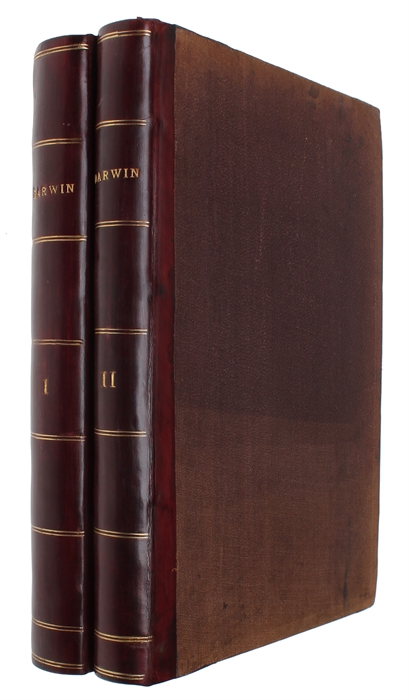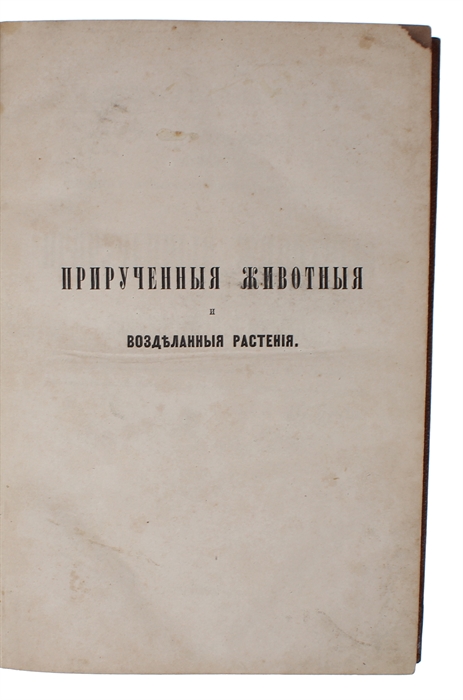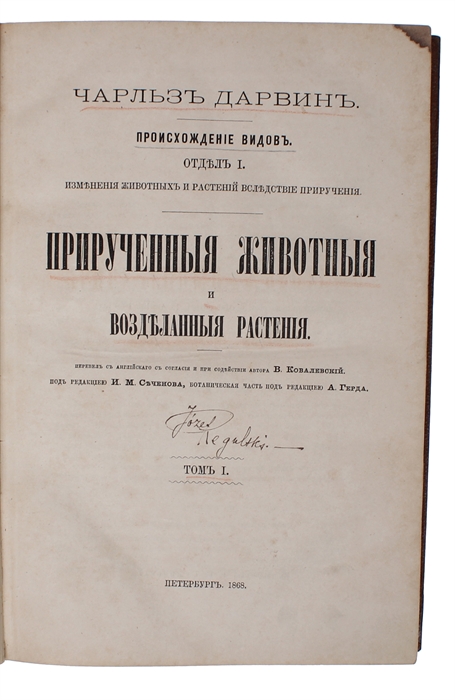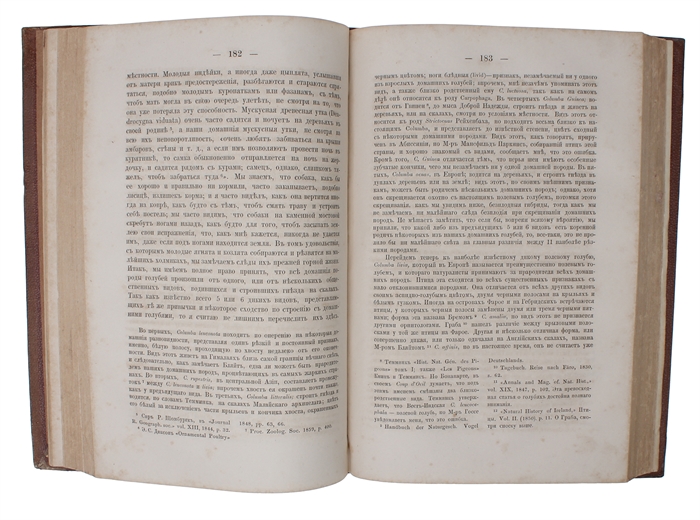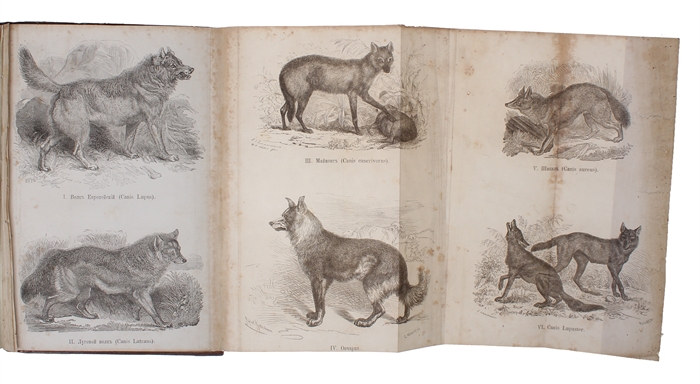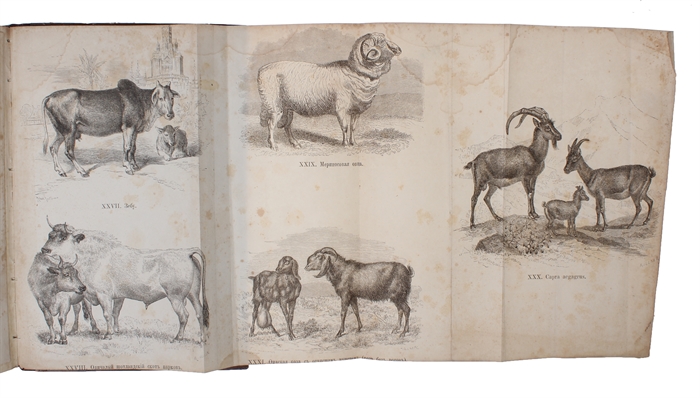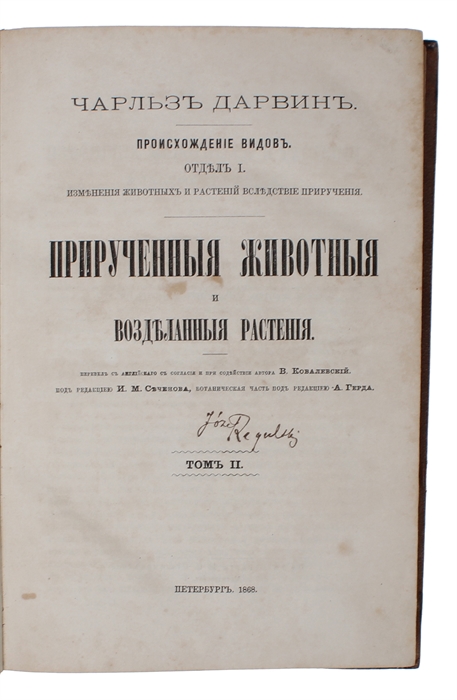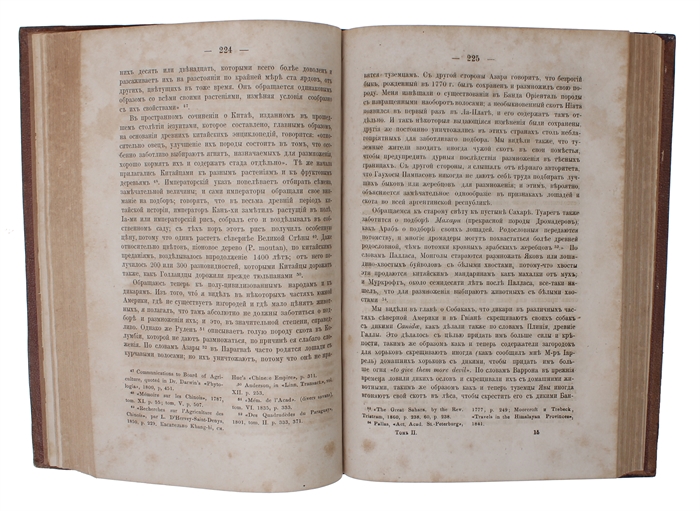THE VERY FIRST PUBLICATION OF DARWIN'S 'VARIATION UNDER DOMESTICATION' IN ANY LANGUAGE.
DARWIN, CHARLES.
Priruchennyie zhivotnyie i vozdelannyie rasteniya [i.e. Russian "The Variation of Animals and Plants under Domestication". Translated from English with the consent and assistance of the author by V. Kovalevsky. Edited by I. M. Sechenov, botanical section edited by A. Gerdt]. 2 vols.
St. Petersburg, 1868 [but in fact 1867-1869].
8vo. In contemporary half calf with renewed spine. Inner hindges with repairs and boards with soiling and a few marks and holes to volume 1. Light foxing throughout, primarily affecting margins and plates. Overall a good copy. IV, 443, (1): ill; V.2: 462, (I)-VI pp.
The very first publication of Darwin's 'Variation under Domestication' in any language. The title-page states 1868 but they two volumes were in fact published, respectively in November 1867 and 1869.
"In August, 1867, Darwin wrote to Lyell that he was visited by a young Russian "who is translating my new book into Russian.". The book was the 'Variation of Animals and Plants under Domestication', and the youngRussian was Vladimir Kovalevsky, who subsequently became a well-known evolutionary palaeontologist. At that time the 'Variation' was not yet published, and it seems most probably that the translation was made from a set of proofs given to Kovalevsky by Darwin. Thanks to Kovalevsky's rapid work, the first section of the Russian translation of the Variation was published several months prior to the publication of the English original." (Glick, The Comparative Reception of Darwinism, p. 235)
"The first Russian edition, which is dated 1868 on the volume title page, is of particular interest. It is the only work, in his lifetime, of which any part appeared in foreign translation before it appeared in English. Correspondence at Cambridge shows that the translator was sent copies of corrected proofs as they were ready. It was published in seven parts of which four, perhaps to the end of Chapter XV, appeared in 1867; the next two appeared in 1868, and the last not until 1869, because he had been away in Russian Asia. The title is given in full, in English translation, under No. 925 and has been discussed above" (Freeman).
Vladimir Kovalevsky (1842-1883), the translator of this book, was a Russian biologist and the founder of evolutionary palaeontology. His own scientific works were printed between 1873 and 1877, and according to Henry Osborn (Osborn, H. The rise of Mammalia in North America // Proc. Amer. Assoc. Sci. 1894. vol. 42, pp. 189-227) they ''dare away'' all traditional and dry European paleontology. That was mainly because Kovalevsky was a devoted Darwinist and adapted Darwin's ideas to palaeontology. Luis Dollo, the Belgian palaeontologist, a contemporary of Kovalevsky's, described him thus: ''No palaeontologist embodies so perfectly our epoch, as the brilliant and miserable Vladimir Kovalevsky, friend and guest of the immortal Charles Darwin''. Indeed, Kovalevsky was a friend of Darwin's and they corresponded extensively. When visiting Darwin in 1877, the Russian botanist, Timiryazev, asked Darwin about his views on Russian science and Darwin surprised him with an answer that Vladimir Kovalevsky (little known at the time) was the bright hope of palaeontology.
Kovalevsky was very eager to translate Darwin into Russian as soon as possible so he asked Darwin to send him the proofs of his book chapter by chapter as soon as Darwin finished them. Kovalevsky translated with great speed (the complete book contains 900 pages) and he began to print the chapters from July 1867 (the first English edition appeared on 30th January 1868). The chapters were printed one after another as the translation went on. It is unclear whether any part of it appeared before the English edition.
Vladimir Kovalevsky translated another of Darwin's books, The Expression of the Emotions in Man and Animals [O vyrazhenii emotsyi u cheloveka I zhyvotnikh] that appeared the same year as the English edition (1872).
Kovalevsky committed suicide at the age of forty after the breakdown of his marriage to the celebrated mathematician, Sophia Kovalevskaya who became the first female professor of mathematics in the world.
OCLC finds only three complete copies worldwide (Cornell, American Philosophical Society (US) and Thomas Fisher Library, (Canada)).
Freeman 925
Order-nr.: 59981

